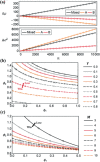Generalized Solutions of Parrondo's Games
- PMID: 33344113
- PMCID: PMC7740106
- DOI: 10.1002/advs.202001126
Generalized Solutions of Parrondo's Games
Abstract
In game theory, Parrondo's paradox describes the possibility of achieving winning outcomes by alternating between losing strategies. The framework had been conceptualized from a physical phenomenon termed flashing Brownian ratchets, but has since been useful in understanding a broad range of phenomena in the physical and life sciences, including the behavior of ecological systems and evolutionary trends. A minimal representation of the paradox is that of a pair of games played in random order; unfortunately, closed-form solutions general in all parameters remain elusive. Here, we present explicit solutions for capital statistics and outcome conditions for a generalized game pair. The methodology is general and can be applied to the development of analytical methods across ratchet-type models, and of Parrondo's paradox in general, which have wide-ranging applications across physical and biological systems.
Keywords: Brownian ratchets; Parrondo's paradox; analytical methods; game theory; generalized solutions; noise; non‐linear dynamics.
© 2020 The Authors. Published by Wiley‐VCH GmbH.
Conflict of interest statement
The authors declare no conflict of interest.
Figures



References
-
- Rousselet J., Salome L., Ajdari A., Prostt J., Nature 1994, 370, 446. - PubMed
-
- Parrondo J. M. R., Harmer G. P., Abbott D., Phys. Rev. Lett. 2000, 85, 5226. - PubMed
-
- von Smoluchowski M., Phys. Z. 1912, XIII, 1069.
-
- Feynman R. P., Leighton R. B., Sands M., The Feynman Lectures on Physics, Vol. 1, Addison‐Wesley, Reading, MA: 1963.
LinkOut - more resources
Full Text Sources
